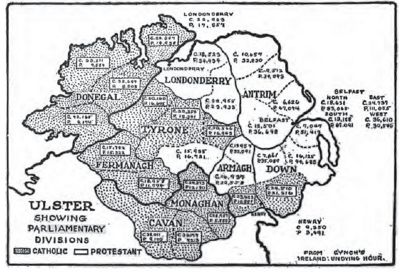Northern Ireland: Difference between revisions
imported>Richard Jensen mNo edit summary |
imported>Richard Jensen |
||
| Line 9: | Line 9: | ||
The Great depression was hard on the economy, with unemployment reaching 30%. The war changed all that, as there was full employment, and agriculture was mobilized for the war effort as well. There was no conscription, but the rate of volunteering was high. | The Great depression was hard on the economy, with unemployment reaching 30%. The war changed all that, as there was full employment, and agriculture was mobilized for the war effort as well. There was no conscription, but the rate of volunteering was high. | ||
After the war the departure of Éire from the Commonwealth in 1949 brought constitutional assurance that Northern Ireland would remain part of the UK as long as a majority there so wished. The new Labour government in London worked well with the conservative Unionists in Belfast, for the Unionist Party welcomed the increased spending on welfare (which helped further differentiate it from Éire. Renewed economic growth helped ensure that the 1950s and early 1960s were Northern Ireland's most harmonious and promising years; its post-war experience contrasted starkly with the relative stagnation and isolation of the south. Unionist confidence led to the willingness of some party members to consider reform, as the political system had long been notoriously corrupt and inefficient. Meanwhile, the voting behaviour of the Catholic minority, its increasing political activism, and the collapse of the IRA campaign of 1956–62 all suggested that Catholics were becoming more reconciled to permanent partition, but they were still angry at the restricted local government franchise, gerrymandering, religious discrimination by government and business, and the inadequacy of state funding for Catholic schools.<ref> Brian Barton, "Brooke, Basil Stanlake, first Viscount Brookeborough (1888–1973)", Oxford Dictionary of National Biography, 2004 online </ref> | |||
==Bibliography== | ==Bibliography== | ||
Revision as of 10:51, 14 September 2007
Northern Ireland
Geography
History
see Ulster Unionism
1939-1969
The Great depression was hard on the economy, with unemployment reaching 30%. The war changed all that, as there was full employment, and agriculture was mobilized for the war effort as well. There was no conscription, but the rate of volunteering was high.
After the war the departure of Éire from the Commonwealth in 1949 brought constitutional assurance that Northern Ireland would remain part of the UK as long as a majority there so wished. The new Labour government in London worked well with the conservative Unionists in Belfast, for the Unionist Party welcomed the increased spending on welfare (which helped further differentiate it from Éire. Renewed economic growth helped ensure that the 1950s and early 1960s were Northern Ireland's most harmonious and promising years; its post-war experience contrasted starkly with the relative stagnation and isolation of the south. Unionist confidence led to the willingness of some party members to consider reform, as the political system had long been notoriously corrupt and inefficient. Meanwhile, the voting behaviour of the Catholic minority, its increasing political activism, and the collapse of the IRA campaign of 1956–62 all suggested that Catholics were becoming more reconciled to permanent partition, but they were still angry at the restricted local government franchise, gerrymandering, religious discrimination by government and business, and the inadequacy of state funding for Catholic schools.[1]
Bibliography
- Adamson, Ian. The Identity of Ulster, 2nd edition (Belfast, 1987)
- Bardon, Jonathan. A History of Ulster (Belfast, 1992.)
- Bew, Paul, Peter Gibbon and Henry Patterson, Northern Ireland 1921-1994: Political Forces and Social Classes (1995)
- Brady, Claran, Mary O'Dowd and Brian Walker, eds. Ulster: An Illustrated History (1989)
- Brady, Ciaran, ed. The Encyclopedia of Ireland: An A-Z Guide to Its People, Places, History, and Culture. Oxford U. Press, 2000. 390 pp.
- Buckland, Patrick. A History of Northern Ireland (Dublin, 1981)
- Connolly, S. J. ed. The Oxford Companion to Irish History (1998) online edition
- Cunliffe, Barry et al., ed. The Penguin Atlas of British and Irish History. 320 pp.
- Donnelly, James S., ed. Encyclopedia of Irish History and Culture. Macmillan Reference USA, 2004. 1084 pp.
- Edwards, Ruth Dudley. An Atlas of Irish History. 2d ed. Methuen, 1981. 286 pp.
- Elliott, Marianne. The Catholics of Ulster: A History. Basic Books. 2001. online edition
- Farrell, Michael. Northern Ireland: The Orange State, 2nd edition (London, 1980)
- Foster, R. F. Modern Ireland, 1600-1972 (1988)
- Graham, B. J. and L. J. Proudfoot, eds. An Historical Geography of Ireland(1993)
- Hachey, Thomas E., Joseph M. Hernon Jr., Lawrence J. McCaffrey; The Irish Experience: A Concise History M. E. Sharpe, 1996 online edition
- Henessy, Thomas. A History of Northern Ireland, 1920-1996. St. Martin's, 1998. 365 pp.
- Hickey, D. J. and Doherty, J. E. A Dictionary of Irish History since 1800. Barnes & Noble, 1980. 615 pp.
- Lalor, Brian. (ed), The Encyclopedia of Ireland (Gill & Macmillan, 2003) (ISBN 9780717130009)
- Ruckenstein, Lelia and O'Malley, James A. Everything Irish: The History, Literature, Art, Music, People, and Places of Ireland from A-Z. Ballantine, 2003. 496 pp.
- ↑ Brian Barton, "Brooke, Basil Stanlake, first Viscount Brookeborough (1888–1973)", Oxford Dictionary of National Biography, 2004 online
